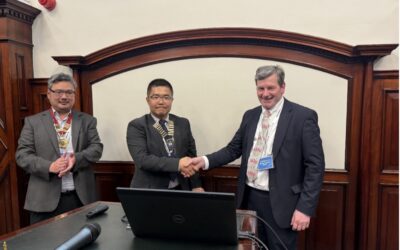For the chemical reactions they derived the reaction equilibrium constants and for the electrochemical reactions calculated the standard electrode potentials by Gibbs free energy and determined partial reaction potentials by the Nernst equation.
Fluid hydrodynamics plays a critical role in influencing corrosion, so studies were conducted by fitting electrodes flush with the inside pipe walls at straight and angled positions to measure corrosion rate with flow and with impingement angle to the pipe wall. Other effects that were incorporated in the flow model were the inhibitive effect of the hydrocarbon oil phase and the erosive effect of inorganic sand and solids.
Another consideration for UoC modelling was the organic acid that is always part of the fluid in upstream hydrocarbon pipelines and which will attack the iron carbonate film which readily forms on the inner walls of the pipe. The scale builds faster with higher CO2 and temperature but, when the FeCO3 scale is broken locally at a defect, this leads to pitting corrosion under the scale and can lead to accelerated attack and leaks in pipeline walls. Pitting corrosion also occurs under sand layers which settle on the pipe floor from the high upstream sand concentration in the oil sand.
The final and possibly greatest issue in oil pipeline corrosion was determined as internal microbial corrosion which is believed to be responsible for ~ 40% of all internal corrosion events in pipelines. Microbial Corrosion occurs under any deposit mixture of petroleum sludge, sands, water microorganisms and corrosion. Internal operating environments encourage growth of the microbial population products. However, in the case of gas pipelines a thin layer of water condensate occurs on the chilled wall of the pipe which makes the formation of biofilms difficult and the deposit of corrosion films more favourable, so there is a competition between the two effects.
Several predictive corrosion models have been developed from the experimental studies of parameters and mathematical relationships, and these UoC models can assist in identifying critical corrosion locations, especially pitting and erosive corrosion on a long-distance pipeline, then predict the pitting corrosion rate and pitting growth rate, however corrosion mitigation and control by operators should not rely on inhibitors and biocides as they are not a totally satisfactory solution and periodic pigging is still required as main method of control in removing and reducing deposits and sludge.
This very comprehensive presentation generated much interest from the audience and many questions that were expertly responded to by the author.
Slides of technical papers for Aberdeen branch events, along with their respective Q&A’s can be found at, https://sites.google.com/site/icorrabz/ and also at Aberdeen Branch – Institute of Corrosion (icorr.org) under Local Technical Programme. A library of event recordings may also be found at:
https://www.youtube.com/results?search_query=ICorr+Aberdeen



